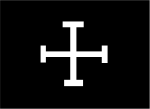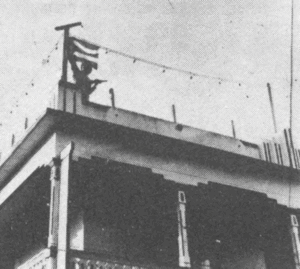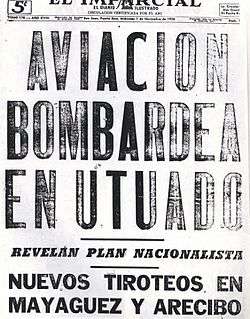Utuado Uprising
| 1950 Utuado Uprising | |
|---|---|
|
"El Imparcial" headline "Aviation Bombs Utuado" | |
| Location | Utuado, Puerto Rico |
| Date | October 30, 1950 |
Attack type | Uprising |
| Weapons | 50-caliber machine guns from four American P-47 Thunderbolt planes. |
| Deaths | 9 Nationalist dead |
Non-fatal injuries | 4 Nationalists wounded |
| Part of a series on the |
| Puerto Rican Nationalist Party |
|---|
 Flag of the Puerto Rican Nationalist Party |
|
Nationalist leaders
|
The Utuado Uprising, also known as the Utuado Revolt or El Grito de Utuado, refers to the revolt against the United States government in Puerto Rico which occurred on October 30, 1950 in various localities in Puerto Rico.
The revolt culminated in the town of Utuado, where five Nationalists were executed without a trial in a police station, in what became known as the "Utuado Massacre."
Events leading to the revolt
On September 17, 1922, the Puerto Rican Nationalist Party was formed. José Coll y Cuchí, a former member of the Union Party, was elected its first president. He wanted radical changes within the economy and social welfare programs of Puerto Rico. In 1924, Pedro Albizu Campos, a lawyer, joined the party and was named its vice president.

Albizu Campos was the first Puerto Rican graduate of Harvard Law School. He served as a Second Lieutenant in the U.S. Army during World War I, and believed that Puerto Rico should be an independent nation - even if that required an armed confrontation. By 1930, Coll y Cuchi departed from the party because of his disagreements with Albizu Campos as to how the party should be run. On May 11, 1930, Albizu Campos was elected president of the Nationalist Party.
In the 1930s, the U.S.-appointed governor of Puerto Rico, Blanton Winship, and police colonel Riggs applied harsh repressive measures against the Nationalist Party.[1] In 1936, Albizu Campos and the leaders of the party were arrested and jailed at the La Princesa prison in San Juan, and later sent to the Federal Prison at Atlanta.
On March 21, 1937, the Nationalists held a parade in Ponce and the police opened fire on the crowd, in what was to become known as the Ponce Massacre. 19 people were killed, including two police officers and 17 unarmed Puerto Ricans - including a 7-year old girl, who was shot in the back. Although the police shot the 18 people, Albizu Campos was arrested, and sentenced to ten years in a U.S. federal prison. Campos finally returned to Puerto Rico on December 15, 1947 after completing his ten-year sentence.
On May 21, 1948, a bill was introduced before the Puerto Rican Senate which would restrain the rights of the independence and Nationalist movements in the island. The Senate, which at the time was controlled by the PPD and presided by Luis Muñoz Marín, approved the bill.[2] This bill, also known as the Ley de la Mordaza (Gag Law) and Law 53, received the approval of the legislature on May 21, 1948. The bill, which resembled the anti-communist Smith Law passed in the United States, was signed into law on June 10, 1948, by the U.S.-appointed governor of Puerto Rico, Jesús T. Piñero and became known as Ley 53 (Law 53).[3]
Under this new law it would be a crime to print, publish, sell, or exhibit any material intended to paralyze or destroy the insular government; or to organize any society, group or assembly of people with a similar destructive intent. Anyone accused and found guilty of disobeying the law could be sentenced to ten years imprisonment, a fine of $10,000 dollars (U.S.), or both.
According to Dr. Leopoldo Figueroa, member of the Partido Estadista Puertorriqueño (Puerto Rican Statehood Party) and the only member of the Puerto Rico House of Representatives who did not belong to the PPD,[4] the law was repressive and in violation of the First Amendment of the US Constitution which guarantees Freedom of Speech.[5]
On June 21, 1948, Albizu Campos gave a speech in the town of Manatí, which explained how this Gag Law violated the First Amendment of the U.S. Constitution. Nationalists from all over the island had gathered - to hear Campos's speech, and to prevent the police from arresting him.
Uprisings

From 1949 to 1950, the Nationalists began to prepare for an armed revolution. The revolution was to take place in 1952, on the date the United States Congress was to approve the creation of the political status of Free Associated State (Estado Libre Associado) for Puerto Rico.
Albizu Campos called for an armed revolution because he considered the "new political status" a colonial farce. Campos picked the town of Jayuya as the headquarters of the revolution because of its location, and weapons were stored in the home of Blanca Canales.

On October 26, 1950, Albizu Campos was holding a meeting in Fajardo when he received word that his house in San Juan was surrounded by police waiting to arrest him. He was also told that the police had already arrested other Nationalist leaders. He escaped from Fajardo and ordered the revolution to start.
On October 27, in the town of Peñuelas, the police surrounded and fired on a caravan of Nationalists, killing four. On October 30, the Nationalists staged uprisings in the towns of Ponce, Mayagüez, Naranjito, Arecibo, Utuado (Utuado Uprising), San Juan (San Juan Nationalist revolt), and Jayuya.
The first incident of the Nationalist uprisings occurred in the pre-dawn hours of October 29. The Insular Police surrounded the house of the mother of Melitón Muñiz Santos, the president of the Peñuelas Nationalist Party in the barrio Macaná, under the pretext that he was storing weapons for the Nationalist revolt. Without warning, the police fired on the house and a gunfight ensued. Two Nationalists were killed and six police officers were wounded.[6] Nationalists Meliton Muñoz Santos, Roberto Jaume Rodriguez, Estanislao Lugo Santiago, Marcelino Turell, William Gutirrez and Marcelino Berrios were arrested and accused of participating in an ambush against the local Insular Police.[7][8]
US response
.jpg)
The United States declared martial law in Puerto Rico and sent the Puerto Rico National Guard, commanded by the Puerto Rico Adjutant General Major General Luis R. Esteves and under the orders of Gov. Luis Muñoz Marín, to attack the various towns involved in the Nationalist uprisings. In the case of Jayuya, the town was attacked by air by U.S. bomber planes and land-based heavy artillery.[9]
The Nationalist leaders in Utuado were the Captain of the Utuado branch of the Cadets of the Republic Heriberto Castro and Damián Torres. According to the plans of Albizu Campos, the Nationalists were to put up an armed resistance in their respective towns and then retreat to Utuado. Once in Utuado, the Nationalists were to continue fighting against the Armed Forces of the United States, until the United Nations Security Council took notice and intervened in their favor.[10]

In Utuado a group of 32 Nationalists fought against the local police. The group was reduced to 12 men, and retreated to the house of Damián Torres - which was promptly strafed by .50-caliber machine guns fire, from ten American P-47 Thunderbolt planes.[11] Three men died from this aerial gunfire.
The National Guard arrived later that day and ordered the nine men who survived the attack to surrender. In addition to the three men killed by the P-47 Thunderbolt planes, these four aircraft which also carried rockets that were five inches wide, and bomb loads of 2,500 pounds, inflicted massive damage to the houses, buildings and roads of both Jayuya and Utuado.[12]
Once the Nationalists surrendered, they were forced to march down Dr. Cueto Street and into the local town plaza - where their shoes, belts and personal belongings were removed. The group was then taken behind the police station where, without a trial, they were gunned down. Five Nationalists were killed: Heriberto Castro, Julio Colón Feliciano, Agustín Quiñones Mercado, Antonio Ramos and Antonio González. González, who was 17 years old was bayoneted.[10] The four survivors were seriously wounded in what became known as "La Masacre de Utuado" (The Utuado Massacre).[12]
United States law mandated that U.S. President Harry Truman take direct charge in all matters concerning Puerto Rico. In addition, the Governor of Puerto Rico, Luis Muñoz Marín was required to consult directly with the White House.[13] But this did not occur.
Aftermath
|
|
The top leaders of the Nationalist party were arrested, including Albizu Campos and the leader of the Jayuya Uprising, Blanca Canales. All of them were imprisoned, and served long jail terms.
On November 1, 1950, Nationalists Griselio Torresola and Oscar Collazo attacked the Blair House with the intention of assassinating U.S. President Truman. Torresola and White House police officer Leslie Coffelt lost their lives in the failed attempt. Collazo was arrested and sentenced to death. His sentence was later commuted to life imprisonment by President Truman, and he eventually received a presidential pardon.[14]
The last major attempt by the Puerto Rican Nationalist Party to draw world attention to Puerto Rico's colonial situation occurred on March 1, 1954. On that day, Nationalist leader Lolita Lebrón and fellow Nationalists Rafael Cancel Miranda, Irving Flores and Andrés Figueroa Cordero attacked the United States House of Representatives. Lebrón and her comrades were charged with attempted murder and other crimes.[14] Gilberto Martínez, one of the last survivors of the Utuado Uprising, died on January 1, 2009.[12]
Incarcerated Nationalists
The following is an FBI list of the Utuado Nationalists who were incarcerated in 1950 and who were still in prison as of 1954.:[15]
- Jose Aviles Maisonet
- Angel Luis Colon Feliciano
- Gilberto Martinez Negron
- Jose Angel Medina Gigueroa
- Juanita Ojeda Maldonado
- Elidio Olivera Albarran
- Octavio Ramos Rosario
Further reading
- "War Against All Puerto Ricans: Revolution and Terror in America’s Colony"; Author: Nelson Antonio Denis; Publisher: Nation Books (April 7, 2015); ISBN 1568585012; ISBN 978-1568585017.
See also
- Puerto Rican Nationalist Party
- Cadets of the Republic
- Ducoudray Holstein Expedition
- Grito de Lares
- Intentona de Yauco
- Ponce Massacre
- Río Piedras massacre
- Puerto Rican Nationalist Party Revolts of the 1950s
- Jayuya Uprising
- San Juan Nationalist revolt
- Truman assassination attempt
- Puerto Rican Independence Party
- List of Puerto Ricans
References
- ↑ "Puerto Rico" By Kurt Pitzer, Tara Stevens, page 224, Published by Hunter Publishing, Inc, 2001, ISBN 1-58843-116-9, ISBN 978-1-58843-116-5
- ↑ "La obra jurídica del Profesor David M. Helfeld (1948-2008)'; by: Dr. Carmelo Delgado Cintrón
- ↑ "Puerto Rican History". Topuertorico.org. January 13, 1941. Retrieved November 20, 2011.
- ↑ "Ley Núm. 282 de 2006 -Para declarar el día 21 de septiembre como el Díadel Natalicio de Leopoldo Figueroa Carreras.". Retrieved 25 April 2016.
- ↑ "Jesús T. Piñero y la Guerra Fria". Issuu. Retrieved 25 April 2016.
- ↑ El ataque Nacionalista a La Fortaleza. by Pedro Aponte Vázquez. Page 7. Publicaciones RENÉ. ISBN 978-1-931702-01-0
- ↑ "pr-secretfiles.net" (PDF). Retrieved 25 April 2016.
- ↑ El ataque Nacionalista a La Fortaleza; by Pedro Aponte Vázquez; Page 7; Publisher: Publicaciones RENÉ; ISBN 978-1-931702-01-0
- ↑ "Remember the 1950 Uprising of October 30: Puerto Rico (also known as the Jayuya upraising) by Carlos Rovira - "Carlito"". Retrieved 25 April 2016.
- 1 2 "HISTORIA DE UTUADO". Retrieved 25 April 2016.
- ↑ Maria Rosado; Pedro Albizu Campos: Las Llamas de la Aurora; pp. 352, 353; Ediciones Puerto pub.; ISBN 1-933352-62-0
- 1 2 3 Claridad Archived May 8, 2009, at the Wayback Machine.
- ↑ "Partido Nacionalista de Puerto Rico". Retrieved 25 April 2016.
- 1 2 Ribes Tovar et al., p.132
- ↑ "pr-secretfiles.net" (PDF). Retrieved 25 April 2016.